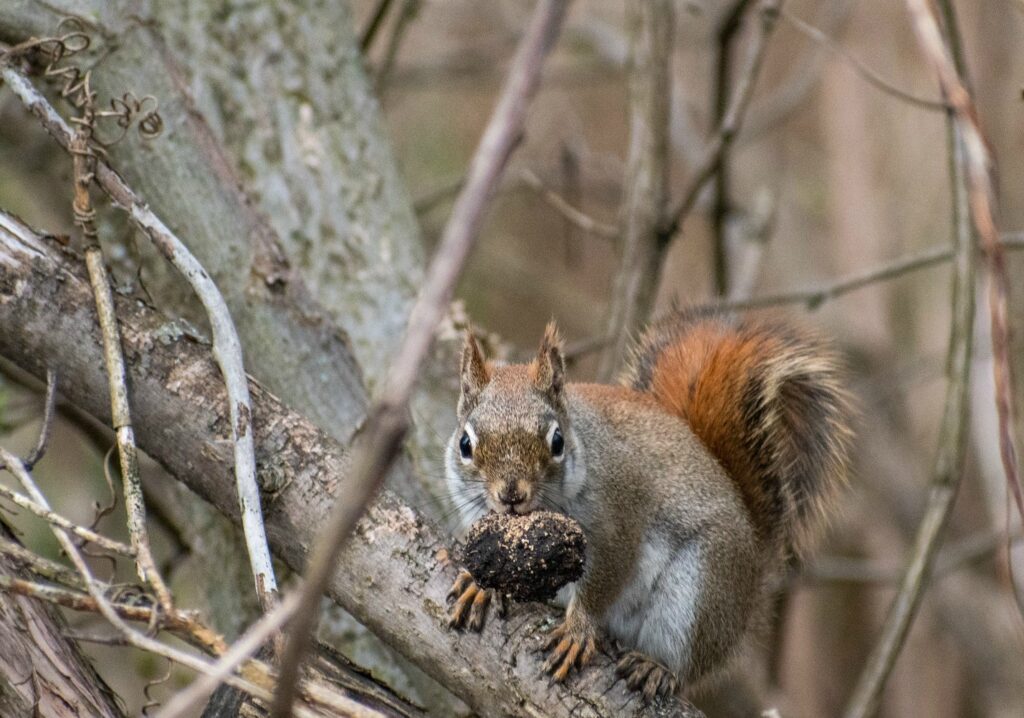The bright orange, yellow and crimson colors of leaves signal the changing season.
They flutter to the ground silently with the autumn breeze. Something else is falling from the trees– they make a kerplunk, clank, or rat-a-tat as they fall on the roof, deck or driveway. They’re nuts!
Rich in carbohydrates, protein, fats, and trace minerals, nuts are a vital food source for wildlife. Squirrels, chipmunks, rodents, foxes, raccoons, even deer and black bears rely on them. Many birds including jays, woodpeckers, grackles, chickadees, wrens, juncos, wild turkeys, and wood ducks also feed on nuts.
Lured by the rich nutrients within a nut, migrating birds, hibernating mammals, and wildlife preparing for winter seek them out. This relationship between trees which produce nuts and wildlife is a mechanism for spreading seeds and creating new trees. Animals may eat nuts and leave the seeds in their droppings or store nuts and forget where they are hidden. Either way, many will germinate to produce new trees.
What is a nut? They are produced by deciduous trees and shrubs, those that shed leaves each year. Trees that produce nuts are called mast-producing trees. “Masts” are fruits, berries, nuts and seeds which wildlife eat. Because of its hard shell, a nut is classified as a “hard mast” whereas fruit is a “soft mast.” An interesting fact to impress your friends over dinner: peanuts are not actually a nut! They grow underground and are a legume.
The nut is produced when the bloom of a tree is fertilized by the wind or pollinating insects. Remember when your allergies were suffering earlier this spring, especially on breezy days? In Indiana, oak, hickory, and black walnut trees are the largest producers of nuts. Less common are the American beech and butternut trees.
When ripe, nuts fall from the trees. Walnuts start in September, followed by hickory nuts and acorns in October and November. Black Walnuts are encased in a green hull. Rich in flavor and edible, they are not quite the same as the walnuts you find in the store. You can harvest them to eat, but beware, the juice from the flesh has a near-permanent dark brown stain.
Acorn production from oak trees can fluctuate from year to year like apple trees in a boom or bust cycle. Some years raking the acorns from the yard is more work than the leaves! Much easier to crack, and a favorite of squirrels, their flesh has a bitter flavor due to the tannins in the nut’s content. Most of the tannins are located at the bottom of the acorn surrounding the seed embryo. Just like their leaves, the shape, size, and cap on acorns are unique for each oak tree species.
Indiana has 16 species of hickory trees. Many of their nuts taste awful to humans. Much easier to crack than walnuts, the hull has four parts and splits to reveal the nutshell. The shagbark hickory is our most prevalent and has the best tasting nut. Easy to identify, they have tall, straight trunks, and their bark peels up from the underside giving a “shaggy” appearance.
The Indiana Forestry Department purchases nuts to diversify its seed source for tree seedling production. Wildlife knows the best time to collect nuts is soon after they fall. Weevils and other insects also like to eat nuts which can then become moldy. To check if a nut is still viable for planting or eating, soak them in a bucket of water. If they float, they are no longer good.
While you enjoy the autumn colors produced by our beautiful local trees, wildlife are scurrying about enjoying the other fall product of trees: nuts.
Julie Borgmann is the Executive Director for Red-tail Land Conservancy. Her passion is connecting people to nature for conservation and wellbeing.
Photo by Kyle Allen Johnson




